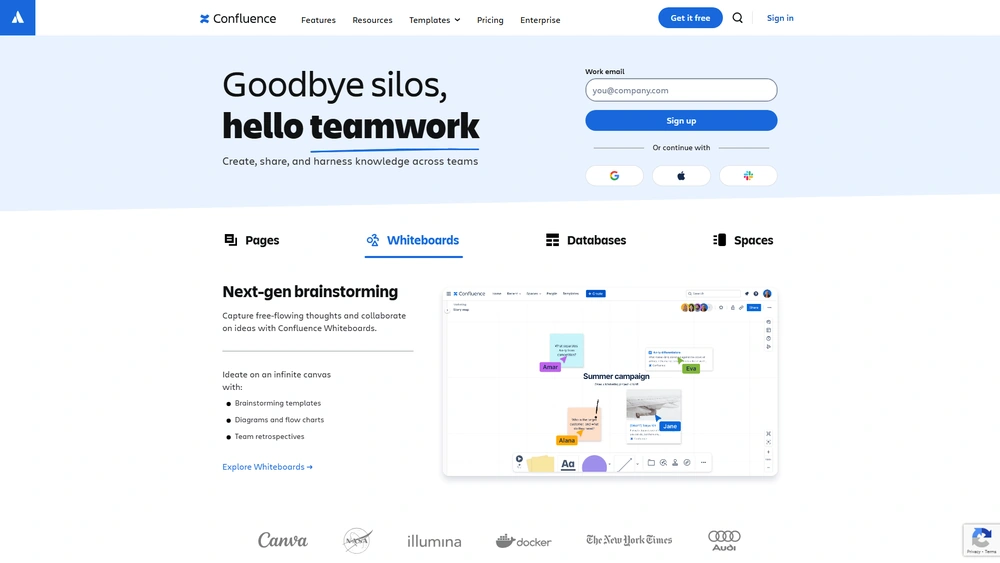Atlassian Confluence Overview & 2025 Industry Position
Atlassian Confluence stands as one of the most recognized and widely-used knowledge management and team collaboration tools, designed to centralize workspaces and make knowledge accessible and actionable. As of 2025, its role has expanded beyond a simple wiki-style documentation tool to an intelligent, integrated hub that supports enterprise knowledge graphs, AI-driven content suggestions, automated workflows, and secure team collaboration across distributed hybrid environments.
With an entrenched presence in digital-first organizations, Atlassian Confluence is essential for teams looking to future-proof their operations and ensure that institutional knowledge is retained, enriched, and usable across platforms. It holds a strategic place in the broader Atlassian ecosystem, tightly coupling with Jira, Trello, and other work management products.
From Launch to 2025: Atlassian Confluence’s Journey
The journey of Confluence began in 2004 when Atlassian introduced it as a team-oriented collaboration and documentation tool designed for technical and non-technical users alike. Originally conceived to streamline software project documentation, it quickly expanded into broader knowledge and content management.
- 2004: Initial release as a team wiki solution.
- 2012: Integration with Jira deepened, making Confluence part of a holistic agile planning environment.
- 2016: Introduction of Confluence Cloud, creating new avenues for scalability and adoption.
- 2020: New editor experience significantly improved usability and formatting control.
- 2023: AI-based features and automation tools were rolled into Confluence Premium and Enterprise tiers.
- 2025: Expanded AI-assisted knowledge base functionality, robust compliance layers (GDPR, SOC2, HIPAA), and cross-platform collaborative intelligence define its competitive edge.
2025 Thesis: In a fragmented digital workplace, Atlassian Confluence becomes the AI-native backbone for capturing, connecting, and scaling enterprise knowledge.

Atlassian Confluence Key Features
- Dynamic Pages: Rich content editing for wikis, KBs, and collaborative documents.
- AI-Powered Suggestions: Smart labels, tag recommendations, and knowledge graph links.
- Templates Gallery: 100+ contextualized templates for project kickoffs, design specs, retrospectives, etc.
- Team Spaces: Segmented, permissioned areas for departments and projects.
- Real-Time Collaboration: Multiple users can comment, annotate, or edit simultaneously.
- Advanced Search: Machine-assisted search helps discover hidden or related content.
- Compliance Settings: Admin controls for data residency, retention, and regulatory compliance.
Workflow & UX
Confluence has made significant strides in user experience, particularly with the rollout of the Smart Links and the editor overhaul. Its workflows are structured around nested pages, tagging, and comment-driven revisions. Users can drag-and-drop multimedia, embed Jira issues, and add macros like decision trees, polls, or tabbed content. The onboarding experience is now structured via AI-assisted guides that auto-suggest templates based on team goals, and keyboard-driven controls enhance productivity for power users.
Pro Tip: Embed Jira tickets directly into Confluence pages using Smart Links to create real-time reporting dashboards and improve dev–PM alignment.
Atlassian Confluence Pricing Analysis & Value Metrics
| Plan | Monthly (Per User) | Key Inclusions |
|---|---|---|
| Free | $0 | 10 users, basic pages, limited templates, 2GB storage |
| Standard | $5.75 | Unlimited users, permissions, 250GB storage, basic analytics |
| Premium | $11 | Advanced admin controls, automation, 24/7 support, 1TB storage |
| Enterprise | Custom | Multi-instance, sandbox, audit logs, unlimited storage |
Value Verdict: Premium delivers exponential ROI with its AI and automation enhancements, perfect for scaleups and midsize firms moving beyond siloed documentation practices.
Competitive Landscape
| Tool | Strength | Weakness | Best For |
|---|---|---|---|
| Notion | Customizability, inline databases | Limited fine-permission control | Design teams, solo users |
| Microsoft Loop | Tightly integrated with M365 suite | Still maturing product | MS-centric orgs |
| Asana Goals | Workflow-native documentation | Poor exportability | Product ops |
| Atlassian Confluence Premium | Scalability, ecosystem integration | Learning curve | Cross-functional teams |
Use Cases
- Software project documentation linked directly to Jira tickets
- HR playbooks, onboarding kits, and SOP libraries
- Customer success portals and product education content
- Cross-specialist brainstorming with embedded whiteboard tools
- Distributed team status updates and asynchronous workflows
Integrations That Matter
Atlassian Confluence integrations are perhaps its biggest differentiator. Native tie-ins include Jira, Trello, Bitbucket, Slack, Google Drive, Microsoft 365, Miro, Lucidchart, Dropbox, Zoom, and thousands more through its Atlassian Marketplace.
This expansive ecosystem enables automation, knowledge syncing, and one-tap workflows from dev to ops to product. Enterprise toolchains are fully supported, including identity provider integrations like Okta or Azure AD.
Pros & Cons
- Pros:
- Deep Jira/Atlassian ecosystem integration
- Powerful AI enhancements for enterprise knowledge
- Templates accelerate onboarding
- Compliance-ready for regulated industries
- Cons:
- Steep learning curve for new admins
- Custom permissions setup can be tedious
- Performance can lag with image-heavy pages
Final Thoughts
Atlassian Confluence in 2025 is best suited for growing companies and large enterprises aiming to formalize and scale institutional knowledge. Teams already using Jira or Bitbucket benefit most from its frictionless integration. Its robust templating, AI features, and compliance readiness make it future-proof—but some complexity remains for configuration-heavy use cases.
Atlassian Confluence FAQ
Yes. Atlassian Confluence offers a free plan for up to 10 users with basic features and 2GB of document storage.
You can embed and reference Jira issues inside Confluence pages, enabling project documentation that reflects real-time updates from Jira boards.
Yes. It includes advanced permission controls, audit logging, and supports SSO providers like Okta and Azure AD for secure access.
Tech, finance, healthcare, legal, and education sectors all benefit due to the need for centralized, secure, and searchable knowledge systems.
Yes, Confluence supports document import tools for platforms like Google Docs, Notion, and Microsoft Word to ease migration.